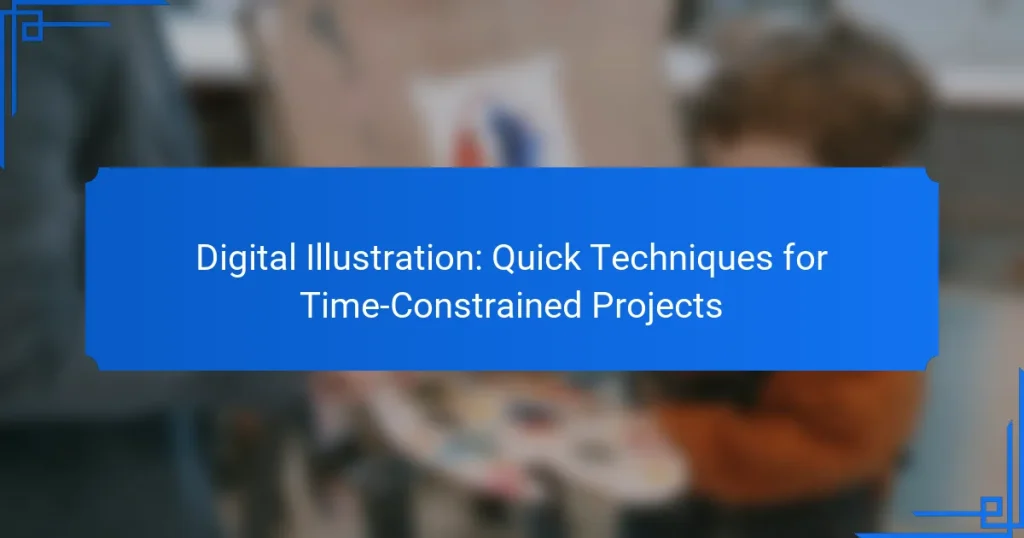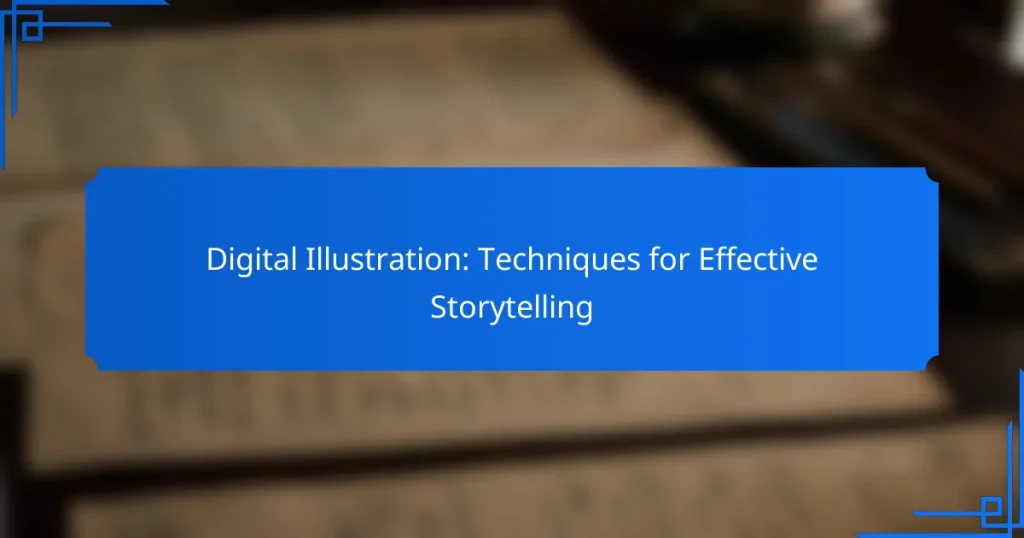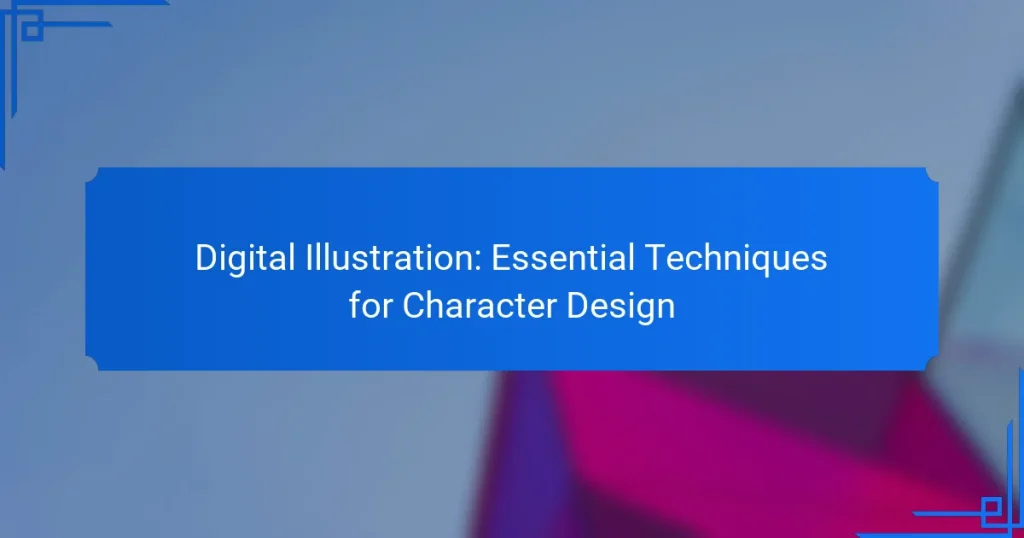Digital illustration encompasses a variety of techniques, including vector, raster, 3D, mixed media, and digital painting, each offering distinct characteristics and applications. Choosing the right technique is crucial and should align with your project’s requirements, your skill level, and the expectations of your audience. Familiarity with essential tools like Adobe Illustrator, Procreate, and Corel Painter can further enhance your creative process and output.
Digital Illustration: Techniques for Effective Storytelling
Digital Illustration: Essential Techniques for Character Design
What Are the Best Digital Illustration Techniques?
The best digital illustration techniques include vector, raster, 3D, mixed media, and digital painting. Each technique has unique characteristics, tools, and applications, making them suitable for different styles and projects.
Vector Illustration
Vector illustration uses mathematical equations to create images that can be scaled infinitely without losing quality. This technique is ideal for logos, icons, and illustrations that require clean lines and sharp edges.
Common software for vector illustration includes Adobe Illustrator and CorelDRAW. When working with vectors, focus on using layers and shapes to build your design, ensuring flexibility for future edits.
Raster Illustration
Raster illustration relies on a grid of pixels to create images, making it suitable for detailed artwork like photographs and complex textures. Unlike vector images, raster graphics can lose quality when resized.
Popular tools for raster illustration include Adobe Photoshop and Procreate. When creating raster images, consider the resolution; a higher DPI (dots per inch) is essential for print quality, typically around 300 DPI.
3D Illustration
3D illustration involves creating three-dimensional models and scenes, allowing for realistic representations and dynamic perspectives. This technique is widely used in animation, gaming, and product visualization.
Software like Blender and Autodesk Maya are commonly used for 3D illustration. When starting, focus on mastering basic modeling techniques and understanding lighting and texturing to enhance realism.
Mixed Media Illustration
Mixed media illustration combines traditional and digital techniques, allowing artists to blend various materials and styles. This approach can create unique textures and visual effects that stand out.
To experiment with mixed media, consider using hand-drawn elements, scanned textures, and digital enhancements. Balance your traditional and digital components to maintain a cohesive look throughout your artwork.
Digital Painting
Digital painting mimics traditional painting techniques using digital tools, allowing for a wide range of styles from realism to abstract. This technique is popular among concept artists and illustrators for its versatility.
Software like Adobe Fresco and Corel Painter are excellent for digital painting. When painting digitally, utilize brushes that replicate traditional media and experiment with layers to build depth and detail in your artwork.
How to Choose the Right Technique for Your Project?
Selecting the appropriate digital illustration technique depends on your project’s specific needs, your skill level, and the preferences of your target audience. Understanding these factors will help you make an informed decision that enhances your artwork’s effectiveness.
Consider Project Requirements
Begin by identifying the goals and constraints of your project. Are you creating a detailed character design, a simple logo, or an intricate background? Each type of illustration may require different techniques, such as vector graphics for scalability or raster images for detailed textures.
Additionally, consider the medium where the illustration will be used. For instance, digital illustrations for print may need higher resolutions compared to those intended for web use. Always align your technique with the final output format to ensure optimal quality.
Evaluate Your Skill Level
Your proficiency with various digital illustration tools plays a crucial role in technique selection. If you are a beginner, starting with simpler techniques, such as flat design or basic vector art, can help you build confidence and foundational skills.
As you gain experience, you can explore more complex methods like digital painting or 3D modeling. Assess your comfort level with software like Adobe Illustrator or Procreate, and choose techniques that match your current abilities while allowing room for growth.
Assess Target Audience Preferences
Understanding your audience’s tastes is vital in choosing the right illustration technique. Conduct research to identify the styles that resonate with your target demographic, whether they prefer minimalist designs or vibrant, detailed artwork.
Consider creating mood boards or sketches to gather feedback from potential viewers. This can guide your technique choice, ensuring that your illustrations not only meet project goals but also engage and appeal to your intended audience effectively.
What Tools Are Essential for Digital Illustration?
Essential tools for digital illustration include software that caters to various artistic styles and workflows. Popular options like Adobe Illustrator, Procreate, Corel Painter, and Clip Studio Paint each offer unique features tailored to different needs and preferences.
Adobe Illustrator
Adobe Illustrator is a vector-based graphic design software widely used for creating illustrations, logos, and typography. It allows artists to create scalable graphics without losing quality, making it ideal for both print and digital media.
When using Illustrator, take advantage of its extensive toolset, including the Pen tool for precise paths and the Shape Builder tool for complex shapes. Consider utilizing layers to organize your work efficiently, and explore the vast library of brushes and effects to enhance your designs.
Procreate
Procreate is a powerful digital illustration app designed specifically for the iPad, favored for its intuitive interface and responsiveness. It supports a wide range of brushes and allows for high-resolution canvases, making it suitable for detailed artwork.
Artists can benefit from Procreate’s layering system and the ability to create custom brushes. The app also offers time-lapse recording, which is useful for sharing the creative process. Ensure your iPad is compatible and updated to get the best performance from Procreate.
Corel Painter
Corel Painter is renowned for its realistic brush simulation, making it a favorite among traditional artists transitioning to digital. It offers a variety of brushes that mimic real-world media, such as oil paints and watercolors, providing a natural painting experience.
When using Corel Painter, experiment with different brush settings to find the right texture and flow for your artwork. The software also includes powerful tools for photo painting and texture creation, which can enhance your illustrations significantly.
Clip Studio Paint
Clip Studio Paint is particularly popular among comic and manga artists due to its specialized features for character design and panel layout. It offers both raster and vector capabilities, allowing for flexibility in illustration styles.
Utilize Clip Studio Paint’s extensive brush library and customizable tools to create unique effects. The software also supports 3D models, which can be a helpful reference for perspective and anatomy. Consider exploring its animation features if you’re interested in motion graphics.
What Are the Common Challenges in Digital Illustration?
Digital illustration presents several challenges, including mastering software tools, ensuring consistency across projects, and navigating various file formats. Addressing these issues is crucial for creating high-quality digital artwork efficiently.
Understanding Software Features
Familiarity with software features is essential for effective digital illustration. Each program, whether Adobe Illustrator, Procreate, or CorelDRAW, offers unique tools and functionalities that can enhance your workflow. Spend time exploring tutorials and practice using different features to maximize your efficiency.
For instance, understanding layers, brushes, and color palettes can significantly impact your creativity and productivity. Take advantage of built-in help resources or community forums to troubleshoot and learn new techniques.
Maintaining Consistency
Consistency in style and technique is vital for digital illustrators, especially when working on a series or for a client. Establishing a clear style guide can help maintain uniformity in colors, line weights, and overall aesthetics. This guide serves as a reference point throughout your project.
Additionally, using templates can streamline the process and ensure that elements like typography and layout remain consistent. Regularly reviewing your work against your style guide can help catch deviations early in the process.
Managing File Formats
Choosing the right file formats is crucial for preserving the quality and usability of your digital illustrations. Common formats include PNG for web use, TIFF for high-quality prints, and SVG for scalable graphics. Understanding the strengths and weaknesses of each format can help you make informed decisions based on your project’s needs.
Be mindful of file size and compatibility issues, especially when sharing your work. For example, while PNG files maintain high quality, they can be larger than JPEGs, which may affect loading times on websites. Always save a master copy in a versatile format like PSD or AI for future edits.


